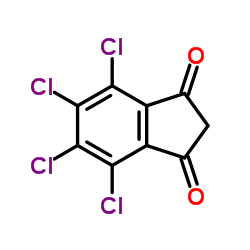30675-13-9
| Name | 4,5,6,7-tetrachloroindene-1,3-dione |
|---|---|
| Synonyms |
1H-Indene-1,3(2H)-dione, 4,5,6,7-tetrachloro-
4,5,6,7-Tetrachloro-1H-indene-1,3(2H)-dione Ubiquitin C-Terminal Hydrolase L3 Inhibitor Ubiquitin Thiolesterase L3 Inhibitor 4,5,6,7-Tetrachloroindan-1,3-dione 4,5,6,7-Tetrachlorindan-1,3-dion 4,5,6,7-Tetrachlorphenyl-1,3-indandion 4,5,6,7-tetrachloroindane-1,3-dione UCH-L3 Inhibitor TCID Ubiquitin C-Terminal Esterase L3 Inhibitor |
| Description | TCID (4,5,6,7-Tetrachloroindan-1,3-dione) is a potent and selective neuronal ubiquitin C-terminal hydrolase (UCH-L3) inhibitor with an IC50 of 0.6 μM[1]. TCID diminishes glycine transporter GlyT2 ubiquitination in brainstem and spinal cord primary neurons[2]. |
|---|---|
| Related Catalog | |
| Target |
IC50: 0.6 μM (UCH-L3) and 75 μM (UCH-L1)[1] |
| In Vitro | TCID (4,5,6,7-Tetrachloroindan-1,3-dione; compound 11) inhibits UCH-L1 with an IC50 of 75 μM[1]. TCID (10 μM; 1, 2 hours) diminishes glycine transporter GlyT2 ubiquitination in brainstem and spinal cord primary neurons[2]. |
| References |
| Density | 1.8±0.1 g/cm3 |
|---|---|
| Boiling Point | 448.1±45.0 °C at 760 mmHg |
| Melting Point | 218-220ºC |
| Molecular Formula | C9H2Cl4O2 |
| Molecular Weight | 283.923 |
| Flash Point | 188.8±29.3 °C |
| Exact Mass | 281.880890 |
| PSA | 34.14000 |
| LogP | 3.94 |
| Vapour Pressure | 0.0±1.1 mmHg at 25°C |
| Index of Refraction | 1.652 |
| Storage condition | -20℃ |
Synonym: Section 2 - COMPOSITION, INFORMATION ON INGREDIENTS
Risk Phrases: 36/37/38 Section 3 - HAZARDS IDENTIFICATION EMERGENCY OVERVIEW
Irritating to eyes, respiratory system and skin. Potential Health Effects Eye: Causes eye irritation. Skin: Causes skin irritation. May be harmful if absorbed through the skin. Ingestion: May cause irritation of the digestive tract. May be harmful if swallowed. Inhalation: Causes respiratory tract irritation. May be harmful if inhaled. Chronic: Not available. Section 4 - FIRST AID MEASURES Eyes: Flush eyes with plenty of water for at least 15 minutes, occasionally lifting the upper and lower eyelids. Get medical aid. Skin: Get medical aid. Flush skin with plenty of water for at least 15 minutes while removing contaminated clothing and shoes. Ingestion: Get medical aid. Wash mouth out with water. Inhalation: Remove from exposure and move to fresh air immediately. If not breathing, give artificial respiration. If breathing is difficult, give oxygen. Get medical aid. Notes to Physician: Treat symptomatically and supportively. Section 5 - FIRE FIGHTING MEASURES General Information: As in any fire, wear a self-contained breathing apparatus in pressure-demand, MSHA/NIOSH (approved or equivalent), and full protective gear. Extinguishing Media: Use water spray, dry chemical, carbon dioxide, or chemical foam. Section 6 - ACCIDENTAL RELEASE MEASURES General Information: Use proper personal protective equipment as indicated in Section 8. Spills/Leaks: Vacuum or sweep up material and place into a suitable disposal container. Section 7 - HANDLING and STORAGE Handling: Avoid breathing dust, vapor, mist, or gas. Avoid contact with skin and eyes. Storage: Store in a cool, dry place. Store in a tightly closed container. Section 8 - EXPOSURE CONTROLS, PERSONAL PROTECTION Engineering Controls: Facilities storing or utilizing this material should be equipped with an eyewash facility and a safety shower. Use adequate ventilation to keep airborne concentrations low. Exposure Limits CAS# 30675-13-9: Personal Protective Equipment Eyes: Not available. Skin: Wear appropriate protective gloves to prevent skin exposure. Clothing: Wear appropriate protective clothing to prevent skin exposure. Respirators: Follow the OSHA respirator regulations found in 29 CFR 1910.134 or European Standard EN 149. Use a NIOSH/MSHA or European Standard EN 149 approved respirator if exposure limits are exceeded or if irritation or other symptoms are experienced. Section 9 - PHYSICAL AND CHEMICAL PROPERTIES Physical State: Solid Color: brown Odor: Not available. pH: Not available. Vapor Pressure: Not available. Viscosity: Not available. Boiling Point: Not available. Freezing/Melting Point: 220 deg C Autoignition Temperature: Not available. Flash Point: Not available. Explosion Limits, lower: Not available. Explosion Limits, upper: Not available. Decomposition Temperature: Solubility in water: Specific Gravity/Density: Molecular Formula: C9H2Cl4O2 Molecular Weight: 284 Section 10 - STABILITY AND REACTIVITY Chemical Stability: Not available. Conditions to Avoid: Incompatible materials. Incompatibilities with Other Materials: Strong oxidizing agents. Hazardous Decomposition Products: Hydrogen chloride, carbon monoxide, carbon dioxide, acrid smoke and fumes. Hazardous Polymerization: Not available. Section 11 - TOXICOLOGICAL INFORMATION RTECS#: CAS# 30675-13-9 unlisted. LD50/LC50: Not available. Carcinogenicity: 4,5,6,7-Tetrachloroindane-1,3-dione - Not listed by ACGIH, IARC, or NTP. Section 12 - ECOLOGICAL INFORMATION Section 13 - DISPOSAL CONSIDERATIONS Dispose of in a manner consistent with federal, state, and local regulations. Section 14 - TRANSPORT INFORMATION IATA No information available. IMO No information available. RID/ADR No information available. Section 15 - REGULATORY INFORMATION European/International Regulations European Labeling in Accordance with EC Directives Hazard Symbols: XI Risk Phrases: R 36/37/38 Irritating to eyes, respiratory system and skin. Safety Phrases: S 26 In case of contact with eyes, rinse immediately with plenty of water and seek medical advice. S 37/39 Wear suitable gloves and eye/face protection. WGK (Water Danger/Protection) CAS# 30675-13-9: No information available. Canada None of the chemicals in this product are listed on the DSL/NDSL list. CAS# 30675-13-9 is not listed on Canada's Ingredient Disclosure List. US FEDERAL TSCA CAS# 30675-13-9 is not listed on the TSCA inventory. It is for research and development use only. SECTION 16 - ADDITIONAL INFORMATION N/A |
| Symbol |

GHS07 |
|---|---|
| Signal Word | Warning |
| Hazard Statements | H302 |
| Precautionary Statements | P301 + P312 + P330 |
| Hazard Codes | Xi: Irritant; |
| Risk Phrases | R36/37/38 |
| RIDADR | NONH for all modes of transport |
| HS Code | 2914700090 |
| HS Code | 2914700090 |
|---|---|
| Summary | HS: 2914700090 halogenated, sulphonated, nitrated or nitrosated derivatives of ketones and quinones, whether or not with other oxygen function Tax rebate rate:9.0% Supervision conditions:none VAT:17.0% MFN tariff:5.5% General tariff:30.0% |
